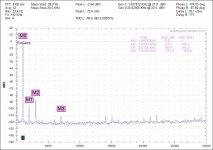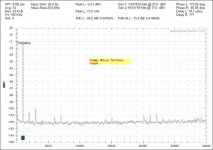Large value ceramics have the most problems of all, and perhaps jjasniew, you have learned something important. It happened to me about 50 years ago, when I had the bright idea that replacing the paper capacitor (about .1uf) with a 2.2uf ceramic cap would improve the output of my vacuum tube Fisher FM tuner.
After all, these ceramic caps were the 'latest thing', actually rather expensive at the time, non-polar, and really space saving. I listened for awhile, and came to the fact that it was a big mistake! It took several years before I accidentally saw how ceramics really performed in a test developed by Tektronix back in 1974. Harmonic distortion is only PART of the problem. Wake up everybody!
After all, these ceramic caps were the 'latest thing', actually rather expensive at the time, non-polar, and really space saving. I listened for awhile, and came to the fact that it was a big mistake! It took several years before I accidentally saw how ceramics really performed in a test developed by Tektronix back in 1974. Harmonic distortion is only PART of the problem. Wake up everybody!
Many moons ago, I tapped one of theses meanies while the power was on, and heard it loud and clear. I decided I have no need of those extra transducers.
Last edited:
I decided to try mounting an X7R capacitor on the bed of one of my CNC milling machines. It drove a microphone level input to an amplifier, the output going to an LED. That way as long as there was light in the office, the machine was working. Light out time to change the work.
Really didn't work! So I found an old and very beat up lavalier condenser microphone. Now it almost works. If other noisy machinery is running the indication is not accurate.
Might actually have to try a contact microphone, but actually spending money, with all the stuff laying around!!! 😉
Really didn't work! So I found an old and very beat up lavalier condenser microphone. Now it almost works. If other noisy machinery is running the indication is not accurate.
Might actually have to try a contact microphone, but actually spending money, with all the stuff laying around!!! 😉
Large value ceramics have the most problems of all, and perhaps jjasniew, you have learned something important. It happened to me about 50 years ago, when I had the bright idea that replacing the paper capacitor (about .1uf) with a 2.2uf ceramic cap would improve the output of my vacuum tube Fisher FM tuner.
After all, these ceramic caps were the 'latest thing', actually rather expensive at the time, non-polar, and really space saving. I listened for awhile, and came to the fact that it was a big mistake! It took several years before I accidentally saw how ceramics really performed in a test developed by Tektronix back in 1974. Harmonic distortion is only PART of the problem. Wake up everybody!
I used ceramic NP0/C0G caps for OITPC compensation in my last amp and took THD1 measurement. After some time I decided to change ceramics for silver mica and repeated the same measurement. I did get different results, attached two THD1 measurements, first NP0/C0G, second silver mica. Nothing else was different. ???
So, maybe ceramic caps are not so good for compensation caps?
Damir
Attachments
Condenser microphones use polystyrene capacitors. They are also widely used in amplifiers Naim. In some expensive Japanese amplifier in my opinion it was a Technics 5000 or Toshiba (Aurex). They used polystyrene capacitors with copper plates. They are usually manufactured with aluminum covers.
Яндекс.Картинки
https://img-fotki.yandex.ru/get/940943/127814835.4/0_1973bd_519a6db_orig.jpg
https://audio-database.com/AUREX/amp/sc-lambda90f(10).JPG
Aurex SC-lambda 90F
Яндекс.Картинки
https://img-fotki.yandex.ru/get/940943/127814835.4/0_1973bd_519a6db_orig.jpg
https://audio-database.com/AUREX/amp/sc-lambda90f(10).JPG
Aurex SC-lambda 90F
Last edited:
I remember Hans Polak's writing once not to have been able to stabilize an oscillating amplifier stage with a C0G capacitor, whereas a siver mica part did the job.
Interesting results Dadod. I’m using COG but must admins I’ve not done a comparative test with silver Mica whic I have used in some past designs.
What voltage were you using?
I am getting 7 ppm at 200 W into 8 ohms but most of that distortion is from the generator.
What voltage were you using?
I am getting 7 ppm at 200 W into 8 ohms but most of that distortion is from the generator.
Interesting results Dadod. I’m using COG but must admins I’ve not done a comparative test with silver Mica whic I have used in some past designs.
What voltage were you using?
I am getting 7 ppm at 200 W into 8 ohms but most of that distortion is from the generator.
If you ask about silver Mica those are 500V, the amp power supply is +-55V and OPS is in Class A with power supply +-7V.
I am using QA400 for THD measuring and not yet very familiar with it, just starting.
I’m using a QA401 as well.
I suppose QA401 is better than QA400.
I used ceramic NP0/C0G caps for OITPC compensation in my last amp and took THD1 measurement. After some time I decided to change ceramics for silver mica and repeated the same measurement. I did get different results, attached two THD1 measurements, first NP0/C0G, second silver mica. Nothing else was different. ???
So, maybe ceramic caps are not so good for compensation caps?
Damir
Very weird, as the mica dielectric is worse that C0G by any metric, including the much discussed DA.
I would look further at differences between the two caps, were the ceramics low voltage and the silver mica high voltage? What was the measured difference between the two caps value?
OTOH, I would think an amplifier that is so sensitive to a compensation cap type (or value) may have some potential stability issues.
Last edited:
I find polystyrene best, (low value) mica second, and polypropylene third. Mylar and COG might be useful in special circumstances. Mylar and mica are both known by me to have some DA, especially Mylar. COG is usually not measured for DA, but I bet it has some also. Thanks for the measurements DD, we need more of these.
Just because you don't read the datasheets, John, doesn't mean they don't measure it:
http://www.farnell.com/datasheets/81357.pdf
Literally from a 20 second Google search.
Their dielectric absorption is typically less than 0.6% which is similar to mica and most films.
http://www.farnell.com/datasheets/81357.pdf
Literally from a 20 second Google search.
I would think an amplifier that is so sensitive to a compensation cap type (or value) may have some potential stability issues.
You are absolutely right. The story that I wrote was a bit different.
The AD797 has a special feature to enhance bandwidth and reduce distortion with a 50pF cap between output and pin8.
When using a 797 in an MC phono preamp, I offered a square wave through an Anti Riaa network to it’s input.
Starting from an amplitude earlier as expected, the output of the amp started to produce a distorted square wave.
When replacing the ceramic NP0 cap by a silver mica cap, the problem was solved.
I mentioned at the same time that it was not at all my intention to disqualify NP0 caps, but it was a strange non expected experience.
Hans
Last edited:
Condenser microphones use polystyrene capacitors.
Where? Most diaphragms are mylar.
I mentioned at the same time that it was not at all my intention to disqualify NP0 caps, but it was a strange non expected experience.
Hans
Never observed that and never had a single customer inquiry on it. OTOH I used only mica or a small air variable cap when I played with trimming the effect.
- Home
- Member Areas
- The Lounge
- The Black Hole......

